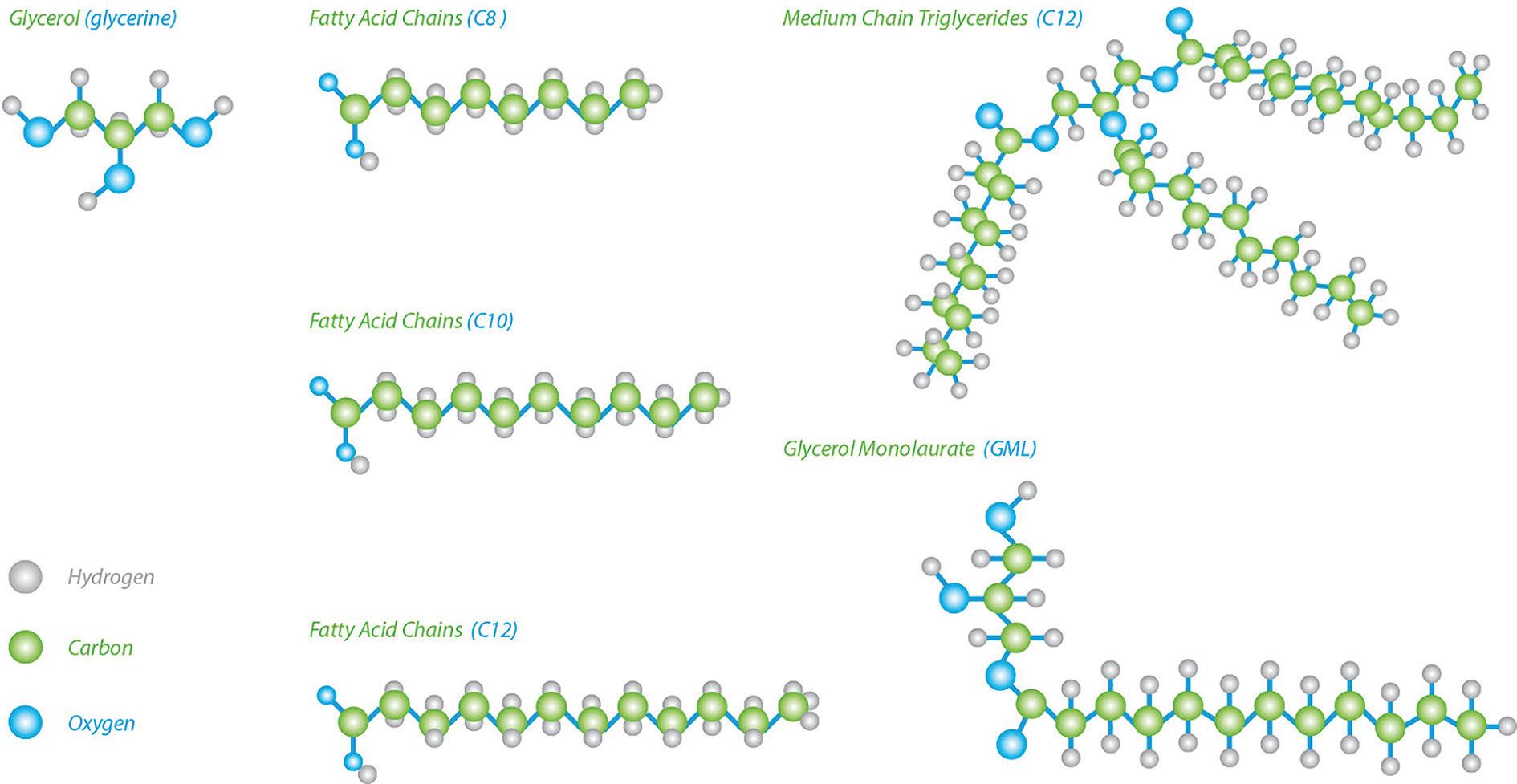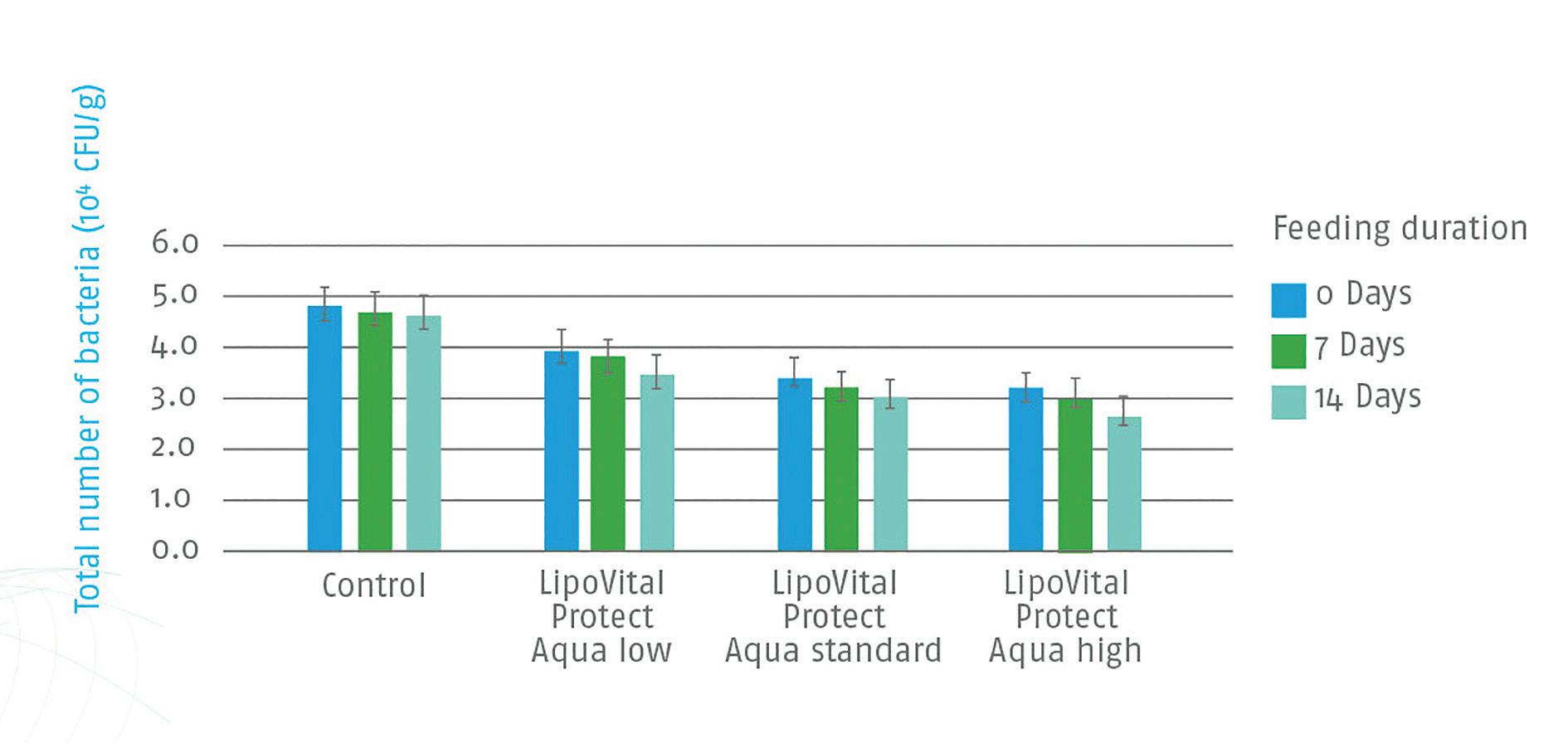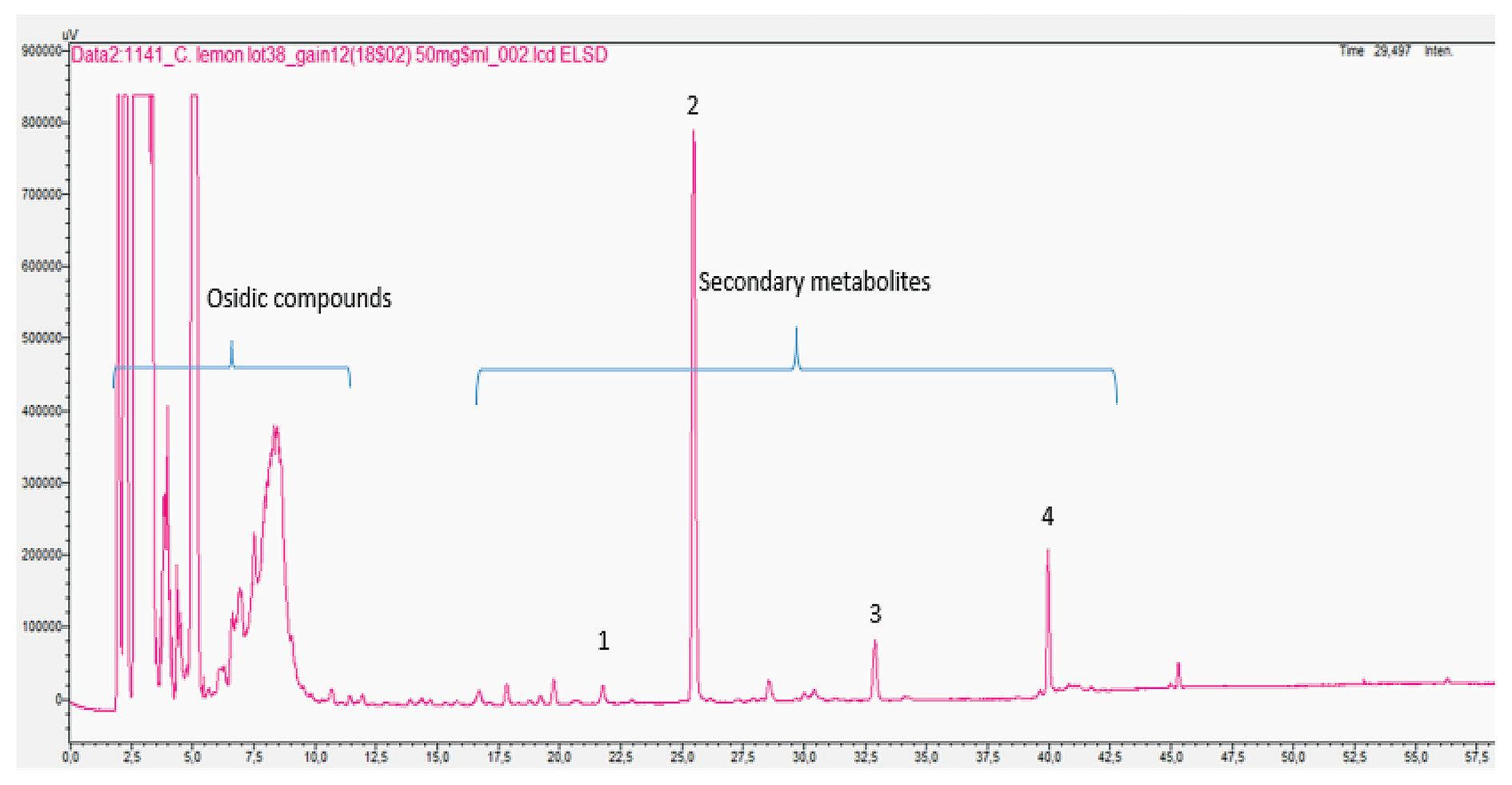
13 minute read
All-natural: Immune protection, enhanced performance
Christian Cordts, Mirona Quandt, Berg + Schmidt
In the fight against bacteria and viruses, there are high hopes for the role played by medium-chain functional lipids. Functional vegetable lipids can improve gut health by positively affecting the microbiota and immune function. Believe it or not, the antimicrobial properties of medium-chain functional lipids have been known since the 1800s, but have previously been overlooked as a value-added feed additive due to the use of antibiotics. Functional lipids incorporated into fish feeds are seen as a method to support immune function, resistance to stress and pathogens, and increase fish production. As such, German feed ingredients manufacturer Berg + Schmidt offers natural functional lipids that support the immune system and growth of fish. Thanks to expert knowledge and innovative technology, the company’s functional lipids and fats are easy to use and offer numerous health benefits.
Gut health: Epicenter of immunity
The hot topic of gut health encompasses a number of factors. These range from an effective digestive function, optimal absorption of nutrients, the absence of gastrointestinal diseases, good immune status, healthy gut flora to the wellbeing of fish and shrimp. The gut microbiota, which resides in the gastrointestinal tract, provides essential health benefits to its host, particularly by regulating immune homeostasis. Moreover, it has become obvious that alterations to the gut microbial composition can cause immune dysregulation. To maintain this delicate status, a balance between nutrient intake, symbiotic microflora and an optimized mucosa must be maintained. Any negative impact on gut flora, e.g. by oral administration of antibiotics, stressful husbandry conditions, an unbalanced diet or stress, can result in reduced functionality and immune power of the gut. Here, medium-chain functional lipids play a key supporting role.
Smart way to beat pathogens
The antimicrobial properties of fatty acids have been known and used for many decades. However, antibiotic-resistant bacteria, legal regulations and increasing consumer demand for sustainable solutions have driven a need for alternatives such as those found in functional lipids. Medium-chain fatty acids, monoglycerides and triglycerides are saturated fatty acids with carbon lengths of 6, 8, 10 and 12, named caproic, caprylic, capric and lauric acids, respectively. Due to their chain length and unique structure (which is shown in Fig. 2) they can be used as antimicrobial, antiviral, antifungal and antiinflammatory agents, and can be referred to as medium-chain functional lipids.
Figure 1. Major points for a healthy gastrointestinal system.
In nature, these lipids are found in palm kernel, coconut oil and milk fat. The most effective and powerful form of medium-chain functional lipids is achieved by esterifying with glycerine to form a monoglyceride. It is vital to attach the fatty acid in the 1-alpha position to achieve maximum efficacy of the medium-chain monoglyceride. This chemical structure provides fatty acids with high emulsifying properties, which enables them to interact with both water and lipids. Typically, free fatty acids exhibit their greatest emulsifying properties at lower pH in their non-ionized form. However, monoglycerides do not have a carboxyl group but instead are bound to glycerol. This imparts monoglycerides with emulsifying properties without being pH sensitive. Depending on the temperature, they can be liquid or solid for use in a wide range of applications.
The antimicrobial mode of action of medium-chain functional lipids is believed to fall into different general categories: increased cell permeability, inhibition of enzymes and nutrient uptake, and disruption of the electron transport chain. Medium-chain functional lipids form double-layered micelles that can fuse with the bacterial cell membrane. This can result in the formation of membrane surface pores and tubes, causing cell leakage. At high enough concentrations, fatty acids can completely solubilize membrane structure and fluidity, impairing the receptors and enzymes necessary to import key nutrients. To disrupt the electron transport chain in the cellular membrane, they bind directly to the transport carriers. This changes the structure via increased membrane fluidity, resulting in less energy for the cell. Other proposed modes of action for medium-chain functional lipids are the lowering of pH inside and outside the cell, reduction of pathogen toxin production, interference with pathogen adhesion and disruption of cell-to-cell signalling.
Trials with shrimp and fish
A study with Penaeus vannamei shrimp, conducted at the Kasetsart University (Bangkok, Thailand), demonstrated that LipoVital Protect Aqua, a special combination of medium-chain fatty monoglycerides, could improve performance and support gut health of fish and shrimps. The trial focused on growth, survival, immune response and intestinal bacteria composition. Numerous preliminary studies in vitro and in vivo compared the synergistic effects of monoglycerides against specific aquaculture pathogens. To determine the effects of LipoVital Protect Aqua on the resilience of white shrimp, the animals were especially challenged with low dissolved oxygen in laboratory conditions.

Figure 2. Structure of medium-chain fatty acids.
Figure 3. Application of the monoglyceride form of Lipovital Protect Aqua.

In conclusion, the study proved that a naturally sourced and specifically composed mix of different medium-chain functional lipids, increased immune function and performance, and reduced the mortality rate. Moreover, LipoVital Protect Aqua reduced the count of Vibrio spp. Figure 3 shows a dosagedependent reduction in the total Vibrio count. Increasing the length of the feeding period with medium-chain functional lipids showed a further reduction in potentially pathogenic bacteria.
At farm level, LipoVital Protect Aqua contributes to more profitable and sustainable production. LipoVital can be supplied as a high-purity raw material, and as a customized compound with desired physical criteria. LipoVital is effective at low doses. The inclusion rate can be increased under challenging conditions. Berg + Schmidt is currently working with renowned institutes on further trials for the use of LipoVital in aquaculture, with promising initial results in salmon and shrimp feeding.
Lecithins: Another powerful ingredient
Besides monoglycerides, lecithins are also a powerful additive providing essential nutrients, stimulating the metabolism, strengthening the immune system and providing high energy content. Furthermore, lecithins are emulsifiers and thus play an important role in fat digestion, and also enable the feed producer to unlock the full energy potential of added oils and fats. Obtained from plants such as soy, rapeseed or sunflower, lecithins can be processed into powders or liquids. Added to feed solutions for aquaculture, they boost the growth rate and development of young fish, advance the feed conversion and liver metabolism.
As an ingredient with added value, lecithins can also facilitate production processes. Their excellent emulsifying capacity improves the miscibility of raw materials and gives pellets or flakes greater elasticity. In addition, production throughput is increased because lecithin acts as a lubricant. Thanks to their antioxidative qualities, finished products score with a longer shelf life. Since the 2000s, Berg + Schmidt has supplied proven products to the aquaculture business.
More information: Christian Cordts
Product Manager Feed Additives Berg + Schmidt GmbH & Co. KG
Mirona Quandt
Product Manager Feed Additives Berg + Schmidt GmbH & Co. KG E: feed@berg-schmidt.com
Nutritional fish & shrimp pathology - II
Albert G. Tacon, Ph.D.
Dr. Albert Tacon is a Technical Editor at Aquafeed.com and an independent aquaculture feed consultant. E: agjtacon@aquahana.com
Disorders in lipid and fatty acid nutrition

This column is the second of a six-part series extracted from a forthcoming publication by the author dealing with the major reported nutritional disorders in farmed fish and shrimp, and represents an update to a previous review published by FAO in 1992 (Tacon, 1992)1 .
Dietary essential fatty acid deficiency
Dietary essential fatty acids (EFA) are important components of fats and oils and may include (depending upon the fish or shrimp species): linoleic acid (18:2n-6), linolenic acid (18:3n-3), eicosapentaenoic acid (EPA 20:5n-3), docosahexaenoic acid (DHA 22:6n-3), and/or arachidonic acid (20:4n6). Dietary EFA are defined as those fatty acids which the fish or shrimp species in question are incapable of synthesizing at a sufficient rate to meet metabolic demand. EFA have numerous important biological roles within the animal body, including serving as essential structural components of all cell membranes, intracellular signaling, hormone production and energy production. Table 1 shows the major reported deficiency signs and health impacts of fish and shrimp fed EFA deficient diets.
As with individual amino acids, the EFA also have functional properties, and as such apart from a basic dietary requirement to prevent classic nutritional pathologies for optimum growth and feed efficiency, there is also an additional possible requirement for maximum growth and optimum health under stressful environmental conditions.
Oxidization of dietary lipids
Dietary lipids (including phospholipids, EFA, cholesterol, fat soluble vitamins, and carotenoids) are highly prone to oxidative damage and degradation on prolonged storage; degradation usually being by autooxidation and combing with oxygen via free radical reactions and the subsequent formation of toxic oxidation products, including lipid hydroperoxides and secondary breakdown products. Table 2 shows the reported deleterious effects of feeding oxidized lipids to fish and crustaceans.
It is important to mention, that the deleterious effects of oxidized lipids are two fold, namely 1) the direct toxic effects of the primary and secondary lipid degradation products (hydroperoxides, conjugated dienes/trienes, carbonyls, aldehydes, volatiles, malondialdehyde, oxysterols, etc.) and 2) the loss of essential nutrients through the oxidation process such as the highly reactive long-chain polyunsaturated fatty acids (EPA, DHA) and tissue antioxidants, including a-tocopherol (vitamin E), vitamin C, carotenoids and antioxidant enzymes (superoxide dismutase, catalase and glutathione peroxidase).
Notwithstanding the above, under practical farming conditions, the potential deleterious effects of oxidized or rancid dietary lipids can be reduced and/ or eliminated through the increased use of dietary a-tocopherol, and to a lesser extent with supplemental vitamin C, vitamin A, selenium, vitamin premix, and glutathione. In addition to the use of natural antioxidants, it is also common practice for feed ingredient suppliers and feed manufacturers to use synthetic antioxidants to prevent lipid peroxidation, including ethoxyquin, butylated hydroxytoluene (BHT), butylated hydroxyanisole (BHA) and propyl gallate (PG). Although the efficacy of synthetic antioxidants is generally less than a-tocopherol, their ready availability
Table 1. Reported essential fatty acid (EFA) deficiency signs and health impacts in farmed fish and shrimp.
Major species – EFA Reported EFA deficiency signs & health impacts 2
Atlantic salmon (Salmo salar)
Blue shrimp (Penaeus stylirostris)
Blunt snout bream (Megalobrama amblycephala) Chum salmon (Oncorhynchus keta) Dover sole (Solea solea) European sea bass (Dicentrarchus labrax) Increased fry mortality, increased heart weight and atheriosclerotic alterations, altered gut microbiota Reduced resistance to environmental stressors & immune response Reduced immune function and antioxidant status Increased mortality, swollen pale livers Reduced larval tolerance to hypoxia Reduced non-specific immune function
Gilthead sea bream (Sparus aurata)
Reduced erythrocyte volume, increased erythrocyte fragility, hemoglobin count, red blood cell count, and reduced cellular immunity, reduced egg production and egg quality, liver granulomatosis, extensive hemorrhages of internal organs, liver degeneration, pericarditis and endocarditis, high occurrence of hydrops in larvae Grass carp (Ctenopharyngodon Idella) Vertebral column curvature (lordosis) Greasy grouper (Epinephelus tauvina & E. fuscoguttatus) Larvae – shock syndrome Japanese seabass (Lateolabrax japonicus) Reduced immune response Milkfish (Chanos chanos) Increased eye abnormality in larvae, increased larval mortality
Nile tilapia (Oreochromis niloticus) Palmetto bass (Morone saxatilis x M. chrysops) Swollen pale livers and high liver lipid content Shock syndrome – larvae
Rainbow trout (Oncorynchus mykiss) Reduced reproductive performance and egg quality, including reduced eyed eggs and hatchability, fin erosion, heart myopathy, shock syndrome, Increased mortality and shock syndrome, poor appetite, shock syndrome, reduced immune response, histological alterations
Red drum (Sciaenops ocellatus) Striped Jack (Pseudocaranx dentex) Increased mortality, fin erosion, shock syndrome Increased mortality
Turbot (Scophthalmus maximus) Altered gill structure, disappearance of chloride cells, "sloughing off" of epithelium along the primary and secondary filaments, accumulation of cellular material in inter-lamellar spaces
White fish (Coregonus lavaretus maraena) White shrimp (Litopenaeus vannamei) Swollen pale livers with histological alterations Reduced antioxidant enzyme activity
Yellowtail (Seriola quinqueradiata) Increased larval mortality (hydrops – floating bodies), disrupted schooling behavior
2 Major reported deficiency signs and health impacts in addition to reduced growth and feed efficiency.
and lower cost has meant that most lipid-rich feed ingredients sources (fishmeal, fish oil, terrestrial animal byproduct meals and fats) and finished aquaculture feeds, are usually stabilized with synthetic antioxidants, and in particular ethoxyquin. However, due to increasing human food safety concerns regarding the possible carry-over effects of synthetic antioxidant residues into fish and shrimp flesh, there is a growing trend toward the reduced use of synthetic antioxidants and the identification and use of more environmentally friendly natural antioxidant sources.
Other reported factors known to promote dietary lipid oxidation include 1) direct exposure of feed containing lipids to light (through photo-oxidation), 2) the presence of dietary pro-oxidants such as inorganic trace elements (such as iron and copper), and 3) the presence of feed ingredients containing lipoxygenase enzymes, such as lipase within rice bran.
1Tacon, A.G.J. (1992). Nutritional fish pathology: morphological signs of nutrient deficiency and toxicity in farmed fish. FAO Technical Paper No. 330, FAO, Rome.75 pp.
Table 2. Reported deleterious effects of feeding oxidized lipids and diets to fish and shrimp.
Major species – EFA
Arctic charr (Salvelinus alpinus) Atlantic cod (Gadus morhua)
Atlantic halibut (Hippoglossus hippoglossus)
Atlantic salmon (Salmo salar)
Black sea bream (Acanthopagrus schlegeli) Channel catfish (Ictalurus punctatus)
Chinese longsnout catfish (Leiocassis longirostris) Coho salmon (Oncorhynchus kisutch) Common carp (Cyprinus carpio)
European seabass (Dicentrachus labrax) Grass carp (Ctenopharyngodon Idella)
Hybrid catfish (Clarias macrocephalus x C. gariepinus)
Largemouth bass (Micropterus salmoide)
Nile tilapia (Oreochromis niloticus)
Rainbow trout (Oncorynchus mykiss)
Red sea bream (Pagrus major) Rohu (Labeo rohita) Senegalese sole (Solea senegalensis) Siberian sturgeon (Acipenser baeri)
Turbot (Scophthalmus maximus) White shrimp (Litopenaeus vannamei) Yellowtail (Seriola quinqueradiata) Yellow catfish (Pelteobagrus fulvidraco)
Reported pathology and health impacts
Reduced growth and higher hepatosomatic index Increased erythrocyte osmotic fragility, decreased liver alpha-tocopherol and increased oxidative stress Increased skeletal deformity: scoliosis and lordosis, reduced growth, reduced plasma glucose levels Reduced oxidative stress, lipoid liver degeneration (LLD) and accumulation of ceroid in hepatocytes Reduced growth and survival rate, increased hepatosomatic index Poor growth, feed efficiency and survival; exudative diathesis, muscular dystrophy and depigmentation; fatty liver and anemia, reduced lipid metabolism and fatty acid synthesis, reduced growth, liver & kidney histological alterations, increased lipid droplet accumulation in the hepatocytes, mitochondrial vacuolation in the renal tubules Lighter tail skin coloration Reduced growth and feed efficiency Reduced growth, high mortality and muscular dystrophy or "Sekoke" disease, muscular dystrophy, damaged gut mucosa Increased erythrocyte fragility and innate immune response Severe intestinal mucosa damage, fatty liver, bile acid accumulation, increased oxidative stress and decreased antioxidant capacity of hepatopancreas, reduced intestine bile acid content, enhanced number of goblet cells, enlarged microvilli and gap between tight junction, hyperplasia and edema of villi, leading to damaged intestinal epithelial tight junction and destruction of the intestinal mucosal epithelium, and increased intestinal oxidative stress Jaundice disease, high mortality, yellow skin & gill pigmentation, enlarged spleen, kidney & gall bladder, pale yellow spleen, kidney, liver & body fat, with yellow ascitic fluid in their abdomen; histologically heavy deposits of hemosiderin and ceroid in the spleen, kidney and liver; decreased haematocrit, RBC count, hemoglobin content, hemolytic anemia associated with lipoid liver degeneration – these symptoms were believed to be due to the feeding of rancid chicken viscera Reduced growth and feed efficiency, increased oxidative damage, decreased hepatosomatic index, increased oxidative stress, histological alterations of liver with hepatocytes with lipid vacuoles and nuclear migration, severe oxidative damage and loss of reducing capacity Marked congestion, with some hemorrhage, in dermal vessels around snout and at bases of pectoral/dorsal fins, lordosis, exophthalmia, abdominal swelling, cataract, orbital collapse, darkening of liver, marked distension of bile duct, steatitis of all abdominal fat bearing tissue, deposits of intracellular ceroid in liver, spleen, kidney and choroid, increased mortality Reduced growth & increased oxidative stress, lipoid liver degeneration due to feeds containing rancid lipids, reduced growth, microcytic anemia & liver lipoid degeneration, reduced growth & feed efficiency, severe muscle damage, increased mortality & increased erythrocyte fragility, reduced red blood cell numbers, hemoglobin content, hematocrit & increased hemolysis, increased mortality, rainbow trout fry syndrome (RTFS) - dystrophic changes in the liver, kidney and muscle, reduced growth & increased oxidative stress Increased oxidative stress, reduced growth and increased oxidative stress Reduced growth and increased oxidative stress Reduced bone mineralization and skeletogenesis Reduced growth, survival, increased oxidative stress & larval deformity in the absence of vitamin A Muscular dystrophy, reduced growth, reduced disease resistance Reduced growth, increased hepatosomatic index & oxidative stress Reduced growth & hematocrit, high mortality Reduced intestinal health & increased goblet cells in foregut










